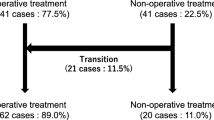Abstract
Background
Despite recent advances in treatment strategies, the management of esophageal perforation is still problematical and controversial. The purpose of the present study was to evaluate and compare the clinical data, treatment methods, and outcomes of patients with esophageal perforation according to the patients’ systemic condition (shock, systemic inflammatory response syndrome (SIRS), or non-SIRS) on arrival to the hospital.
Methods
Twelve patients were treated for an esophageal perforation between 2004 and 2013. Based on the patients’ pretreatment status, the patients were divided into three groups (shock, SIRS, and non-SIRS groups), and their clinical findings, treatment methods, and outcomes were compared.
Results
The numbers of patients in the shock, SIRS, and non-SIRS groups were three, three, and six, respectively. There was a difference in etiologies among the three groups as follows: two patients with spontaneous rupture were in the shock group, two patients with tumor perforation were in the SIRS group, four patients with foreign body were in the non-SIRS group, and patients with iatrogenic causes were included in all groups. The treatment procedures included conservative therapy in 4 non-SIRS patients, primary surgical repair in 4 patients (2 SIRS, 2 non-SIRS), resection in one SIRS patient, and conservative treatment with minor surgical approaches or stenting in 3 shock patients. The mortality rate was 0 %.
Conclusion
Tailoring the treatment strategy to the systemic condition of patients with esophageal perforation is important. In particular, patients with shock should be treated conservatively with minor surgical approaches, including temporary stent insertion.
Similar content being viewed by others
References
Jones WG 2nd, Ginsberg RJ. Esophageal perforation: a continuing challenge. Ann Thorac Surg. 1992;53:534–43.
Reeder LB, De Filippi VJ, Ferguson MK. Current results of therapy for esophageal perforation. Am J Surg. 1995;169:615–7.
Okten I, Cangir AK, Ozdemir N, Kavukçu S, Akay H, Yavuzer S. Management of esophageal perforation. Surg Today. 2001;31:36–9.
Kiernan PD, Rhee J, Collazo L, Byrne WD, Fulcher T, Hettrick V, Vaughan B, Graling P. Thoracic esophageal perforations. South Med. 2003;96:158–63.
Gupta NM, Kaman L. Personal management of 57 consecutive patients with esophageal perforation. Am J Surg. 2004;187:58–63.
Jougon J, McBride T, Delcambre F, Minniti A, Velly JF. Primary esophageal repair for Boerhaave’s syndrome whatever the free interval between perforation and treatment. Eur J Cardiothorac Surg. 2004;25:475–9.
Zumbro GL, Anstadt MP, Mawulawde K, Bhimji S, Paliotta MA, Pai G. Surgical management of esophageal perforation: role of esophageal conservation in delayed perforation. Am Surg. 2002;68:36–40.
Kollmar O, Lindemann W, Richter S, Schilling MK. Boerhaave’s syndrome: primary repair vs. esophageal resection: case reports and meta-analysis of the literature. J Gastrointest Surg. 2003;7:726–34.
Martinez L, Rivas S, Hernández F, Avila LF, Lassaletta L, Murcia J, Olivares P, Queizán A, Fernandez A, López-Santamaría M, Tovar JA. Aggressive conservative treatment of esophageal perforations in children. J Pediatr Surg. 2003;38:685–9.
Vogel SB, Rout WR, Martin TD, Abbitt PL. Esophageal perforation in adults: aggressive, conservative treatment lowers morbidity and mortality. Ann Surg. 2005;241:1016–21 (discussion 1021–23).
Furugaki K, Yoshida J, Hokazono K, Emoto T, Nakashima J, Ohyama M, Ishimitsu T, Shinohara M, Matsuo K. Esophageal ruptures: triage using the systemic inflammatory response syndrome score. Gen Thorac Cardiovasc Surg. 2011;59:220–4.
Levy MM, Fink MP, Marshall JC, Abraham E, Angus D, Cook D, Cohen J, Opal SM, Vincent JL, Ramsay G, SCCM, ESICM, ACCP, ATS, SIS. 2001 SCCM/ESICM/ACCP/ATS/SIS international sepsis definitions conference. Crit Care Med. 2003;31:1250–6.
Moy MP, Levsky JM, Berko NS, Godelman A, Jain VR, Haramati LB. A new, simple method for estimating pleural effusion size on CT scans. Chest. 2013;143:1054–9.
Cameron JL, Kieffer RF, Hendrix TR, Mehigan DG, Baker RR. Selective nonoperative management of contained intrathoracic esophageal disruptions. Ann Thorac Surg. 1979;27:404–8.
Larrieu AJ, Kieffer R. Boerhaave syndrome: report of a case treated non-operatively. Ann Surg. 1975;181:452–4.
Brown RH, Cohne PS. Nonsurgical management of spontaneous esophageal perforation. JAMA. 1978;240:140–2.
Darrien JH, Kasem H. Minimally invasive endoscopic therapy for the management of Boerhaave’s syndrome. Ann R Coll Surg Engl. 2013;95:552–6.
Schweigert M, Beattie R, Solymosi N, Booth K, Dubecz A, Muir A, Moskorz K, Stadlhuber RJ, Ofner D, McGuigan J, Stein HJ. Endoscopic stent insertion versus primary operative management for spontaneous rupture of the esophagus (Boerhaave syndrome): an international study comparing the outcome. Am Surg. 2013;79:634–40.
El Hajj II, Imperiale TF, Rex DK, Ballard D, Kesler KA, Birdas TJ, Fatima H, Kessler WR, Dewitt JM. Treatment of esophageal leaks, fistulae, and perforations with temporary stents: evaluation of efficacy, adverse events, and factors associated with successful outcomes. Gastrointest Endosc. 2014;79:589–98.
Oshiro T, Kasama K, Umezawa A, Kanehira E, Kurokawa Y. Successful management of refractory staple line leakage at the esophagogastric junction after a sleeve gastrectomy using the HANAROSTENT. Obes Surg. 2010;20:530–4.
Inbar R, Santo E, Subchi A-A, Korianski J, Halperin Z, Greenberg R, Avital S. Insertion of removable self-expanding metal stents as a treatment for postoperative leaks and perforations of the esophagus and stomach. Isr Med Assoc J. 2011;13:230–3.
Author information
Authors and Affiliations
Corresponding author
Ethics declarations
Ethical Statement
This article does not contain any studies with human or animal subjects performed by any authors.
Conflict of interest
There are no financial or other relations that could lead to a conflict of interest.
Rights and permissions
About this article
Cite this article
Okumura, H., Uchikado, Y., Kita, Y. et al. Clinical analysis of the diagnosis and treatment of esophageal perforation. Esophagus 13, 146–150 (2016). https://doi.org/10.1007/s10388-015-0504-6
Received:
Accepted:
Published:
Issue Date:
DOI: https://doi.org/10.1007/s10388-015-0504-6




